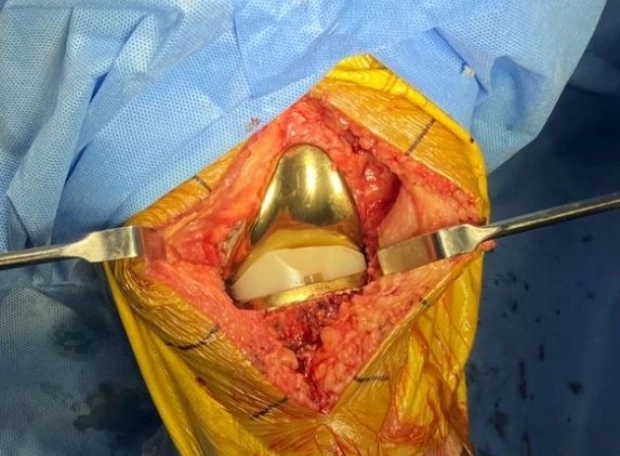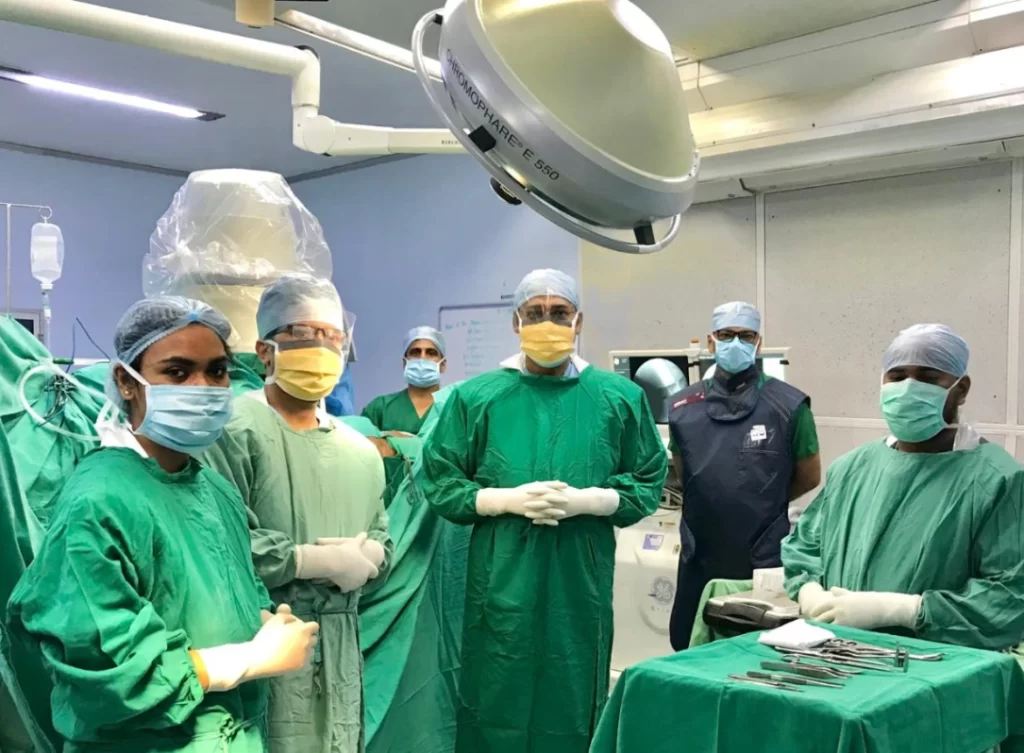
What Is Conventional Joint Replacement Surgery?
Conventional joint replacement surgery is a standard procedure where the surgeon manually replaces a damaged or diseased joint, such as the knee, hip, shoulder, or elbow, with an artificial implant. This technique relies on the surgeon’s expertise, physical measurements, and visual judgment to ensure proper alignment and placement of the implant.
The process involves removing the damaged tissue or bone and inserting a prosthetic joint to restore mobility and reduce pain. While effective, it may lack the advanced precision and customization offered by robotic-assisted techniques.
Orthopedic surgeons in conventional surgery:
- Assess joint damage
- Remove diseased tissue
- Place and align the implant manually
In conventional joint replacement surgery, the procedure is performed manually by the surgeon. The surgeon relies on physical measurements and visual cues to remove the damaged tissue and position the prosthetic implant.
Once the damaged tissue is removed, the surgeon manually inserts the implant, carefully adjusting its position based on these measurements and visual indicators. The precise alignment of the implant is crucial for its long-term success, and the surgeon uses their expertise to ensure the implant fits properly, balancing the joint and minimizing complications
What Is Conventional Knee Replacement Surgery ?
Conventional knee replacement surgery, also known as total knee arthroplasty, is a common procedure for patients suffering from severe knee arthritis, knee joint pain, or knee damage caused by injury. This surgical procedure involves replacing the damaged or worn-out parts of the knee with artificial knee implants made from high-quality materials like metal and plastic.
During traditional knee replacement surgery, a surgeon makes an incision in the front of the knee to access the joint. They then remove the damaged parts of the knee. The surgeon manually places these components, relying on physical measurements and visual cues to ensure correct alignment of the implant.
Dr. Sanjeev Patnaik is the best knee replacement surgeon in Bhubaneswar, specializing in total knee replacement surgery with advanced techniques to ensure effective pain relief and improved joint function


What Is Conventional Hip Replacement Surgery?
Conventional hip replacement surgery is a well-established and widely performed orthopedic procedure designed to provide long-term relief from hip pain caused by conditions such as hip arthritis, rheumatoid arthritis, hip fractures, and other forms of joint degeneration. This surgery involves the removal of the damaged or arthritic components of the hip joint.
In hip replacement surgery, the surgeon makes an incision on the side or front of the hip to access the joint. The damaged bone and cartilage are carefully removed, and the bones are prepared to fit the new prosthetic components, which can be made from materials like metal, ceramic.
If you’re experiencing hip pain , don’t wait any longer. Dr. Sanjeev Patnaik, one of Bhubaneswar’s top orthopedic surgeon, specializes in hip replacement surgery and can guide you through your recovery with expert care.
What Is Conventional Shoulder Replacement ?
Conventional shoulder replacement surgery is a manual procedure designed for patients suffering from chronic shoulder pain caused by arthritis or injury. During this surgery, the damaged portions of the shoulder joint are removed and replaced with an artificial implant, typically made of metal, ceramic, or plastic. The primary goal is to relieve pain, restore function, and improve the range of motion.
If you’re looking for expert shoulder replacement surgery in Bhubaneswar, Dr. Sanjeev Patnaik is a trusted shoulder replacement specialist.


What Is Conventional Elbow Replacement Surgery ?
Conventional elbow replacement surgery involves removing the damaged or arthritic portions of the elbow joint and replacing them with an artificial prosthesis. This procedure is often recommended for patients with severe joint arthritis, fractures, or other degenerative conditions that cause significant pain, limited movement, and disability.
During the surgery, the surgeon makes an incision over the elbow to access the joint. The damaged parts of the humerus (upper arm bone) and the ulna (forearm bone) are removed, and metal or plastic components are used to replace the damaged joint surfaces. The artificial components are designed to restore elbow function, relieve pain, and improve the range of motion.
Dr. Sanjeev Patnaik is a renowned orthopedic & joint replacement surgeon in Bhubaneswar specializing in elbow replacement surgery.
Who Can Benefit From Conventional Joint Replacement?
Conventional joint replacement surgery can benefit a wide range of patients, particularly those suffering from advanced arthritis, including osteoarthritis and rheumatoid arthritis. These patients often experience severe joint pain and reduced mobility due to the degeneration or inflammation of the joint’s cartilage. Joint replacement surgery can offer significant pain relief, restore joint function, and improve overall quality of life.
This procedure is also suitable for individuals with knee or hip deformities, such as misalignment due to conditions like bowing or knock-knees. Additionally, older adults or those who may not be candidates for more complex surgeries due to other health concerns can find conventional joint replacement a reliable solution.

How Do Conventional Joint Replacements Work?
Conventional joint replacement surgeries offer a time-tested and reliable approach to addressing severe joint pain and dysfunction. Using traditional methods, damaged tissues or bone from the affected joint are carefully removed and replaced with a precisely fitted prosthetic.
By employing conventional techniques, a through and effective approach is ensured, tailored to each patient’s specific needs. Additionally, Dr. Sanjeev Patnaik has introduced advanced robotic joint replacement surgery using MISSO technology, offering enhanced precision and promoting faster recovery.
FAQ'S
Common joint replacement surgeries include:
- Knee replacement.
- Hip replacement.
- Shoulder replacement.
- Elbow replacement.
Knee replacement surgery can be performed using two primary methods: conventional (traditional) knee replacement and robotic-assisted knee replacement. Both procedures aim to treat knee pain and improve function, but they differ in how the surgery is performed and the level of precision involved.
The recovery time after hip surgery varies depending on the type of surgery (e.g., total hip replacement or robotic hip replacement), the patient’s overall health, and adherence to rehabilitation.
Knee replacement surgery, also known as knee arthroplasty, is a surgical procedure in which a damaged or worn-out knee joint is replaced with an artificial joint, called a prosthesis. This procedure is commonly recommended for individuals who suffer from severe knee pain, stiffness, and loss of function due to conditions such as osteoarthritis, rheumatoid arthritis, or injury.
There will be some pain and discomfort after shoulder replacement surgery, especially in the initial recovery phase. However, Dr. Sanjeev will provide medications to help manage pain effectively. Following his instructions carefully, including taking prescribed medications on time and engaging in physical therapy, will play a crucial role in reducing pain and ensuring optimal recovery.
After elbow replacement surgery and successful rehabilitation, most patients are able to resume normal daily activities such as walking, driving, and performing light household tasks. However, certain activities may need to be limited or avoided, especially in the initial recovery phase.
Shoulder pain can occur due to a number of possible reasons, including injuries, inflammation, or degenerative diseases.
